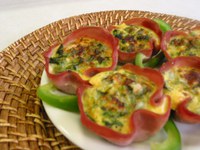Prairie Fare: Tempt Yourself and Others With Healthful Snacks
(Click an image below to view a high-resolution image that can be downloaded)
By Julie Garden Robinson, Food and Nutrition Specialist
NDSU Extension Service
A couple of months ago, I was at a professional conference listening to speaker after speaker. I was getting a little sleepy. Tiny candy bars in multicolored wrappers were in a basket right in front of me. My brain needed glucose, I rationalized.
I kept peeling the wrappers off the chocolate bars and discreetly popping the chocolate in my mouth. Then I noticed the pile of wrappers accumulating by me.
I was going beyond “moderation” really quickly. I quickly threw my wrapper collection in the trash, and I put the basket on another table. I stayed in my original spot at the table, by the way.
Our environment can influence how much we eat and the food choices we make. That’s why vending machines with tempting candy bars, chips and sweetened beverages are no longer an option in many schools.
We can enhance our food environment at home by making healthful choices readily available for ourselves and our family and friends. For example, if you are not meeting the recommendation for about 4 1/2 cups of fruits and vegetables daily, start by altering your food environment.
If fruit is a little lacking in your diet, consider putting a bowl of cut fruit, such as pineapple or cantaloupe, in your refrigerator and ready to serve. Alternatively, put a bowl of apples or bananas on your counter that are ready to grab and go. If you pack your lunch, include a piece of fruit every day.
If you can’t resist chips and candy, either leave them at the grocery store or put a serving, as defined on the nutrition label, in a bowl. Stop with one serving. Pay attention to the flavor and texture of your treat, so you truly enjoy it.
If you really like sweets, enjoy them in moderation. Researchers have shown that the size of serving utensils and bowls can influence how much food people serve themselves.
In a study done by Cornell University researchers, participants were provided a large or small bowl and a large or small serving spoon for ice cream. Those who used the larger bowl served themselves nearly one-third more ice cream. Those who used the larger serving spoon served themselves 15 percent more ice cream. Those who used a large spoon and large bowl took 57 percent more ice cream.
Other Cornell studies have shown that leaving empty bottles, cans, cups and even food waste (such as chicken bones from chicken wings) in front of us can remind us to curb our eating.
If you ever plan snacks or meals for a meeting, whether for a faith community, club or business, provide some healthy options. If you are bringing food for a potluck, consider bringing a large nutrient-rich salad with a variety of greens and sprinkled with dried fruit and nuts or seeds. Bring whole-grain bread or crackers. If you bring desserts, cut them in smaller pieces and consider sprinkling the top with powdered sugar instead of thick frosting.
Try these healthful, tasty snack ideas from the various food groups:
- Grain group: whole-grain minimuffins, banana bread or pumpkin bread, air-popped popcorn, whole-grain crackers
- Vegetable group: baby carrots, broccoli florets, cauliflower, salsa
- Fruit group: grapes, strawberries, melon chunks, oranges, plums, apples, pears; dried fruit; premeasured fruit cups
- Milk group: string cheese and low-fat or fat-free yogurt
- Meat and beans group: unsalted or lightly salted nuts or low-fat bean dip
These miniature quiches make a fun and colorful snack for a meeting or brunch. Serve with sliced fruit, whole-grain rolls and milk and you have a meal.
Mini Ham and Egg Quiches
5 eggs
1/2 c. reduced-fat sharp cheddar cheese, shredded
1/2 c. fat-free cottage cheese
3 ounces frozen spinach, defrosted, water squeezed out and roughly chopped
1/4 c. green or red bell pepper, diced
2 Tbsp. sliced green onions
Pepper to taste
10 to 12 slices reduced-sodium ham or foil muffin tin liners
In a bowl, combine all ingredients (except ham slices) and stir well. If using ham slices, spray muffin tin with nonstick spray and place one piece of ham in each well to form a bowl. If using foil muffin liners, spray the inside of the liners with nonstick spray. Evenly divide egg mixture between the 10 to 12 muffin wells (about 1/4 c. each) Bake at 350 F for 20 minutes.
Storing tip: Store quiches in an airtight container in the fridge or freezer. Remember to remove the foil liner before heating in the microwave. Take frozen quiches out of the freezer the night before serving. When you microwave them, set them on a folded paper towel to drain excess moisture.
Makes 10 to 12 quiches. Each serving (one quiche) has 140 calories, 6 grams (g) of fat, 2 g of carbohydrate, 15 percent of the daily value of calcium and 10 percent of the daily value of vitamin A.
(Julie Garden-Robinson, Ph.D., L.R.D., is a North Dakota State University Extension Service food and nutrition specialist and associate professor in the Department of Health, Nutrition and Exercise Sciences.)
NDSU Agriculture Communication – March 31, 2011
| Source: | Julie Garden-Robinson, (701) 231-7187, julie.garden-robinson@ndsu.edu |
|---|---|
| Editor: | Rich Mattern, (701) 231-6136, richard.mattern@ndsu.edu |



